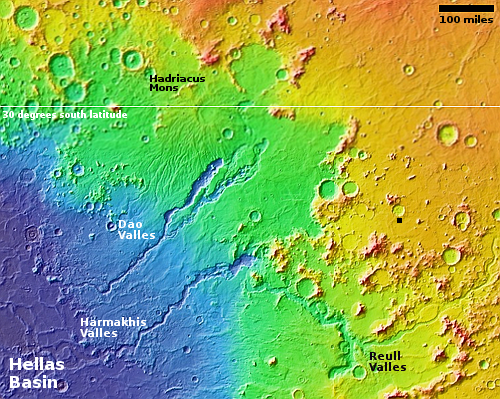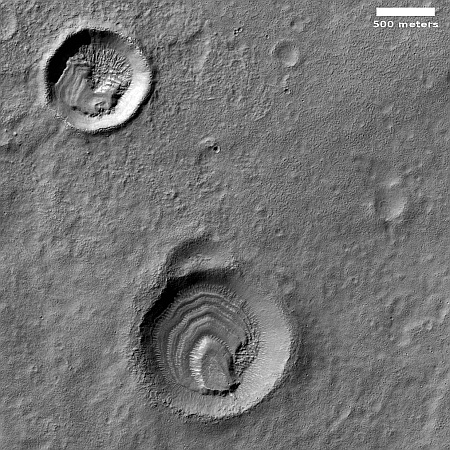Layered glaciers in two small Martian craters
Cool image time! The picture to the right, cropped, reduced, and sharpened to post here, was taken on April 7, 2023 by the high resolution camera on Mars Reconnaissance Orbiter (MRO). It shows what planetary scientists label somewhat vaguely as “layered deposits,” because though the features inside both of these craters strongly resemble glacial ice features, until this is confirmed a good scientist remains skeptical.
I can be more bold, and call the layers glacial in both of these small and very shallow craters (less than a 100 feet deep). To explain this it is important to understand that the lighting and shadows make it hard to distinguish the high points of these layers. Based on the elevation data from MRO, the ground descends to the south, and the mesa in the southern half of each crater’s floor is actually far below the layers and material to the north.
This elevation data suggests that the layered material is surviving best against the crater’s northern interior wall, which at this latitude, about 36 degrees south, will be in shadow the most.

On the overview map to the right, the black dot, on the center right just south of an unnamed 25-mile-crater in the plains above Hellas Basin, marks this location. This is a region of many glaciers, with all three canyons, Dao, Harmakhis, and Reull, filled with glacial features that appear identical to many canyon glaciers on Earth.
As I have noted many times previously, the layers shown here carry the most important information about Mars. Each marks a past climate cycle, caused by the wide swings in the red planet’s rotational tilt, from 11 to 60 degrees, that happen repeatedly. Depending on that tilt, the planet’s water shifts from the mid-latitudes to the poles and then back again. The smaller size of the upper layers tells us that with each cycle Mars had less total water.
On Christmas Eve 1968 three Americans became the first humans to visit another world. What they did to celebrate was unexpected and profound, and will be remembered throughout all human history. Genesis: the Story of Apollo 8, Robert Zimmerman's classic history of humanity's first journey to another world, tells that story, and it is now available as both an ebook and an audiobook, both with a foreword by Valerie Anders and a new introduction by Robert Zimmerman.
The print edition can be purchased at Amazon or from any other book seller. If you want an autographed copy the price is $60 for the hardback and $45 for the paperback, plus $8 shipping for each. Go here for purchasing details. The ebook is available everywhere for $5.99 (before discount) at amazon, or direct from my ebook publisher, ebookit. If you buy it from ebookit you don't support the big tech companies and the author gets a bigger cut much sooner.
The audiobook is also available at all these vendors, and is also free with a 30-day trial membership to Audible.
"Not simply about one mission, [Genesis] is also the history of America's quest for the moon... Zimmerman has done a masterful job of tying disparate events together into a solid account of one of America's greatest human triumphs."--San Antonio Express-News
Cool image time! The picture to the right, cropped, reduced, and sharpened to post here, was taken on April 7, 2023 by the high resolution camera on Mars Reconnaissance Orbiter (MRO). It shows what planetary scientists label somewhat vaguely as “layered deposits,” because though the features inside both of these craters strongly resemble glacial ice features, until this is confirmed a good scientist remains skeptical.
I can be more bold, and call the layers glacial in both of these small and very shallow craters (less than a 100 feet deep). To explain this it is important to understand that the lighting and shadows make it hard to distinguish the high points of these layers. Based on the elevation data from MRO, the ground descends to the south, and the mesa in the southern half of each crater’s floor is actually far below the layers and material to the north.
This elevation data suggests that the layered material is surviving best against the crater’s northern interior wall, which at this latitude, about 36 degrees south, will be in shadow the most.

On the overview map to the right, the black dot, on the center right just south of an unnamed 25-mile-crater in the plains above Hellas Basin, marks this location. This is a region of many glaciers, with all three canyons, Dao, Harmakhis, and Reull, filled with glacial features that appear identical to many canyon glaciers on Earth.
As I have noted many times previously, the layers shown here carry the most important information about Mars. Each marks a past climate cycle, caused by the wide swings in the red planet’s rotational tilt, from 11 to 60 degrees, that happen repeatedly. Depending on that tilt, the planet’s water shifts from the mid-latitudes to the poles and then back again. The smaller size of the upper layers tells us that with each cycle Mars had less total water.
On Christmas Eve 1968 three Americans became the first humans to visit another world. What they did to celebrate was unexpected and profound, and will be remembered throughout all human history. Genesis: the Story of Apollo 8, Robert Zimmerman's classic history of humanity's first journey to another world, tells that story, and it is now available as both an ebook and an audiobook, both with a foreword by Valerie Anders and a new introduction by Robert Zimmerman.
The print edition can be purchased at Amazon or from any other book seller. If you want an autographed copy the price is $60 for the hardback and $45 for the paperback, plus $8 shipping for each. Go here for purchasing details. The ebook is available everywhere for $5.99 (before discount) at amazon, or direct from my ebook publisher, ebookit. If you buy it from ebookit you don't support the big tech companies and the author gets a bigger cut much sooner.
The audiobook is also available at all these vendors, and is also free with a 30-day trial membership to Audible.
"Not simply about one mission, [Genesis] is also the history of America's quest for the moon... Zimmerman has done a masterful job of tying disparate events together into a solid account of one of America's greatest human triumphs."--San Antonio Express-News


